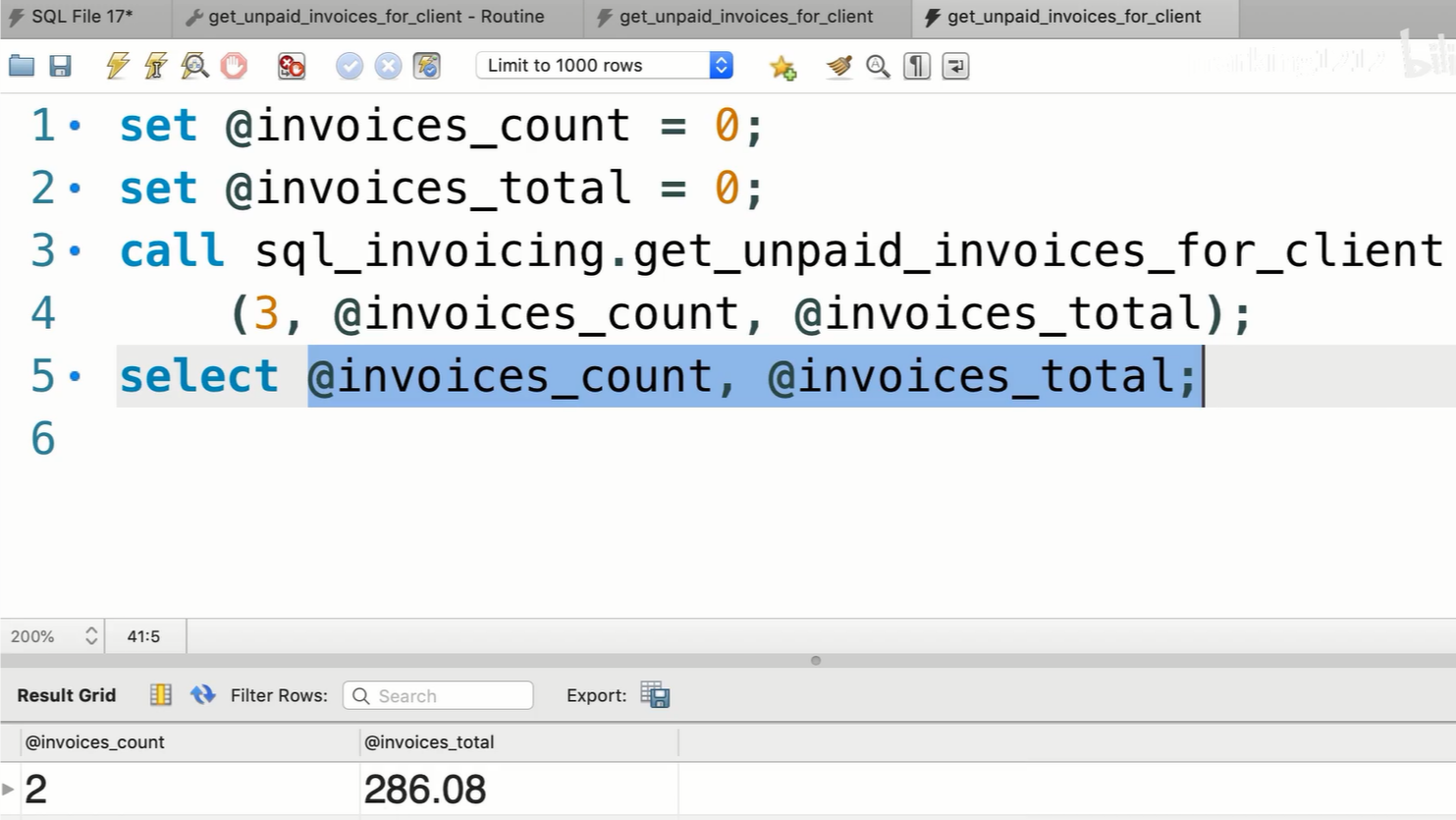上一篇文章中,我们只存储了查询数据的过程,也可以用存储过程来插入、删除、更新数据。

参数验证
1
2
3
4
5
6
7
8
9
10
11
12
13
14
15
16
17
18
|
CREATE PROCEDURE make_payment
(
invoice_id INT,
payment_amount DECIMAL(9, 2), -- decimal带小数点的数,参数1表示总的数字位数,参数2表示保留小数位
payment_date DATE
)
BEGIN
IF payment_amount <= 0 THEN
SIGNAL SQLSTATE '22003'
SET MESSAGE_TEXT = 'Invalid payment amount.';
END IF;
UPDATE invoices i
SET
i.payment_total = payment_amount,
i.payment_date = payment_date
WHERE i.invoice_id = invoice_id;
END
|
1
|
CALL PROCEDURE make_payment(2, -100, '2019-01-01')
|
22003是一个标准代码,代表一个数值类型数据超出了范围。👉ibm-sqlstate
当我们调用过程,传入非法的值,会在输出面板看到异常信息。最好在用户输入的时候提示错误,数据库数据验证是最后一道防线,为防止有人绕过了应用程序直接调用存储过程。
输出参数
上面的实践是通过参数向过程提供参数,那么我们如何让在过程外部获得数据(指定参数)?
1
2
3
4
5
6
7
8
9
10
11
12
|
CREATE PROCEDURE get_invoices_for_client
(
client_id INT, -- 默认是输入参数
OUT invoice_count INT,
OUT invoices_total DECIMAL(9, 2) -- 总位数最多为9,保留两位小数
)
BEGIN
SELECT COUNT(*),SUM(invoice_total)
INTO invoices_count, invoices_total
FROM invoices i
WHERE i.client_id = client_id AND payment_total = 0;
END
|

使用输出参数读取数据有点复杂,不推荐使用。
变量
如上图,存储过程有输出变量的时候,通常是这样定义变量:
1
|
SET @invoices_total = 0
|
这些变量在整个客户端的生命周期中都会存在于内存中,当客户端中止与数据库的连接,变量会释放,称为用户变量(user or session variables)。
还有一种变量称为本地变量(local variables),通常在存储过程或者函数中定义,只要存储过程运行结束,变量就会被释放了。
1
2
3
4
5
6
7
8
9
10
11
12
13
|
CREATE PROCEDURE get_risk_factor
BEGIN
DECLARE risk_factor DECIMAL(9, 2) DEFAULT 0;
DECLARE invoices_count INT;
DECLARE invoices_total DECIMAL(9, 2);
SELECT COUNT(*), SUM(invoice_total)
INTO invoices_count, invoices_total
FROM invoices;
SET risk_factor = invoices_total / invoices_count * 5;
SELECT risk_factor;
END
|
这些变量一旦声明就可以使用,一旦执行结束就会被清除。
函数
函数不同于存储过程的是,函数不能返回带行列的结果集,而是返回单一值。
1
2
3
4
5
6
7
8
9
10
11
12
13
14
15
16
17
18
19
|
CREATE FUNCTION get_risk_for_client
(
client_id INT
)
RETURN INTEGER
READ SQL DATA -- 从数据库读取数据; MODIFES SQL DATA修改数据
BEGIN
DECLARE risk_factor DECIMAL(9, 2) DEFAULT 0;
DECLARE invoices_count INT;
DECLARE invoices_total DECIMAL(9, 2);
SELECT COUNT(*), SUM(invoice_total)
INTO invoices_count, invoices_total
FROM invoices i
WHERE i.client_id = client_id;
SET risk_factor = invoices_total / invoices_count * 5;
RETURN IFNULL(risk_factor, 0);
END
|
调用
1
|
SELECT client_id, name, get_risk_for_client(client_id) AS risk_factor FROM client;
|
删除
1
|
DROP FUNCTION IF EXISTS get_risk_for_client;
|

